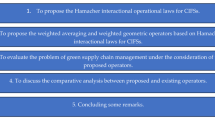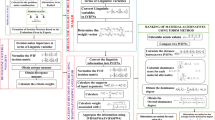Abstract
The intuitionistic fuzzy set (IFS), a popular tool to present decision makers’ cognitive information, has received considerable attention from researchers. To extend the interaction operational laws in the computation of cognitive information, this paper focuses on investigating extensions of geometric interaction aggregation operators by means of the t-norm and the corresponding t-conorm under an intuitionistic fuzzy environment. We develop the extending intuitionistic fuzzy-weighted geometric interaction averaging (EIFWGIA) operator, the extending intuitionistic fuzzy-ordered weighted geometric interaction averaging (EIFOWGIA) operator, the intuitionistic fuzzy weighted geometric interaction quasi-arithmetic mean (IFWGIQAM), and the intuitionistic fuzzy-ordered weighted geometric interaction quasi-arithmetic mean (IFOWGIQAM). We investigate the properties of the proposed extensions and apply the extensions to the cognitive microcredit origination problem. For different generator functions h and ϕ, the proposed IFWGIQAM and IFOWGIQAM degenerate into existing intuitionistic fuzzy aggregation operators or extensions, some of which consider situations that in which no interactions exist between membership and non-membership functions, which can be used in more decision situations. The methods developed in this paper can be used to account for several decision situations. The numerical example demonstrates the validity of the proposed approaches by means of comparisons.
Similar content being viewed by others
References
Akram M, Dudek WA. Intuitionistic fuzzy hypergraphs with applications. Inf Sci. 2013;218:182–93.
Akram M, Alshehri NO, Dudek WA. Certain types of interval-valued fuzzy graphs. J Appl Math. 2013;2013:11. https://doi.org/10.1155/2013/857070.
Atanassov KT. Intuitionistic fuzzy sets. Fuzzy Sets Syst. 1986;80:87–96.
Atanassov KT. New operations defined over the intuitionistic fuzzy sets. Fuzzy Sets Syst. 1994;61:137–42.
Beliakov G, James S, Mordelová J, Rückschlossová T, Yager RR. Generalized Bonferroni mean operators in multi-criteria aggregation. Fuzzy Sets Syst. 2010;161:2227–42.
Beliakov G, Bustince H, Goswami DP, Mukherjee UK, Pal NR. On averaging operators for Atanassov’s intuitionistic fuzzy sets. Inf Sci. 2011;181:1116–24.
Beliakov G, Pradera A, Calvo T. Aggregation functions: a guide for practitioners, vol. 2. Heidelberg: Springer. p. 007.
Bellman RE, Zadeh LA. Decision-making in a fuzzy environment. Manag Sci. 1970;17:B-141–64.
Calvo T, Mesiar R. Aggregation operators: ordering and bounds. Fuzzy Sets Syst. 2003;139:685–97.
Carneiro J, Conceição L, Martinho D, Marreiros G, Novais P. Including cognitive aspects in multiple criteria decision analysis. Ann Oper Res. 2018;265:269–91.
Chen SM, Tan JM. Handling multi-criteria fuzzy decision-making problems based on vague set theory. Fuzzy Sets Syst. 1994;67:163–72.
Chuu SJ. Interactive group decision-making using a fuzzy linguistic approach for evaluating the flexibility in a supply chain. Eur J Oper Res. 2011;213:279–89.
De SK, Biswas R, Roy AR. Some operations on intuitionistic fuzzy sets. Fuzzy Set and Systems. 2000;114:477–84.
Deschrijver G. The Archimedean property for t-norms in interval-valued fuzzy set theory. Fuzzy Sets Syst. 2006;157:2311–27.
Deschrijver G. Arithmetic operators in interval-valued fuzzy set theory. Inf Sci. 2007;177:2906–24.
Deschrijver G. Generalized arithmetic operators and their relationship to t-norms in interval-valued fuzzy set theory. Fuzzy Sets Syst. 2009;160:3080–102.
Dubois D, Prade H. Fuzzy sets and systems: theory and applications. New York: Academic Press; 1980.
Dymova L, Sevastjinov P. An interpretation of intuitionistic fuzzy sets in terms of evidences theory: decision making aspect. Knowl-Based Syst. 2010;23:772–82.
Flavell JH, Miller PH, Social cognition. (1998) In W. Damon (Ed.), Handbook of child psychology: Vol. 2. Cognition, perception, and language (pp.851–898). Hoboken, NJ, US: John Wiley & Sons Inc.
Garg H, Arora R. Dual hesitant fuzzy soft aggregation operators and their application in decision-making. Cogn Comput. 2018;10:769–89.
Gau WL, Buehrer DJ. Vague sets. IEEE Trans Syst Man Cybern. 1993;23:610–4.
He YD, He Z. Extensions of Atanassov’s intuitionistic fuzzy interaction Bonferroni means and their application to multiple attribute decision making. IEEE Trans Fuzzy Syst. 2016;24:558–73.
He YD, Chen HY, Zhou LG, Liu JP, Tao ZF. Intuitionistic fuzzy geometric interaction averaging operators and their application to multi-criteria decision making. Inf Sci. 2014;259:142–59.
He YD, Chen HY, Zhou LG, Han B, Zhao QY, Liu JP. Generalized intuitionistic fuzzy geometric interaction operators and their application to decision making. Expert Syst Appl. 2014;41:2484–95.
Hong DH, Choi CH. Multicriteria fuzzy decision-making problems based on vague set thoery. Fuzzy Sets Syst. 2000;114:103–13.
Jiménez JMM, Vargas LG. Cognitive multiple criteria decision making and the legacy of the analytic hierarchy process. Estudios de Economía Aplicada. 2018;36:67–80.
Klement EP, Mesiar R, editors. Logical, algebraic, analytic, and probabilistic aspects of triangular norms. New York: Elsevier; 2005.
Kolesárová A. Limit properties of quasi-arithmetic means. Fuzzy Sets Syst. 2001;124:65–71.
Li DF. TOPSIS-based nonlinear-programming methodology for multi-attribute decision making with interval-valued intuitionistic fuzzy sets. IEEE Trans Fuzzy Syst. 2010;18:299–311.
Li X, Chen X. D-intuitionistic hesitant fuzzy sets and their application in multiple attribute decision making. Cogn Comput. 2018;10:496–505.
Li J, Wang JQ. Multi-criteria outranking methods with hesitant probabilistic fuzzy sets. Cogn Comput. 2017;9:611–25.
Liu XW. An orness measure for quasi-arithmetic means. IEEE Trans Fuzzy Syst. 2006;14:837–48.
Liu PD, Li HG. Interval-valued intuitionistic fuzzy power Bonferroni aggregation operators and their application to group decision making. Cogn Comput. 2017;9:494–512.
Liu PD, Shi LL. Some neutrosophic uncertain linguistic number Heronian mean operators and their application to multi-attribute group decision making. Neural Comput & Applic. 2017;28:1079–93.
Liu PD, Tang GL. Multi-criteria group decision-making based on interval neutrosophic uncertain linguistic variables and Choquet integral. Cogn Comput. 2016;8:1036–56.
Liu PD, Wang P. Some improved linguistic intuitionistic fuzzy aggregation operators and their applications to multiple-attribute decision making. Int J Inf Technol Decis Mak. 2017;16:817–50.
Liu PD, Zhang XH. A novel picture fuzzy linguistic aggregation operator and its application to group decision-making. Cogn Comput. 2018;10:242–59.
Liu F, Zhang WG, Wang ZX. A goal programming model for incomplete interval multiplicative preference relations and its application in group decision-making. Eur J Oper Res. 2012;218:747–54.
Liu PD, Zhang L, Liu X, Wang P. Multi-valued Neutrosophic number Bonferroni mean operators and their application in multiple attribute group decision making. Int J Inf Technol Decis Mak. 2016;15:1181–210.
Liu PD, Chen SM, Liu J. Some intuitionistic fuzzy interaction partitioned Bonferroni mean operators and their application to multi-attribute group decision making. Inf Sci. 2017;411:98–121.
Meng FY, Chen XH. Correlation coefficients of hesitant fuzzy sets and their application based on fuzzy measures. Cogn Comput. 2015;7:445–63.
Meng FY, Wang C, Chen XH. Linguistic interval hesitant fuzzy sets and their application in decision making. Cogn Comput. 2016;8:52–68.
Merigó JM, Gil-Lafuente AM. The induced generalized OWA operator. Inf Sci. 2009;179:729–41.
Merigó JM, Gil-Lafuente AM. Induced 2-tuple linguistic generalized aggregation operators and their application in decision-making. Inf Sci. 2013;236:1–16.
Peng HG, Wang JQ. Outranking decision-making method with Z-number cognitive information. Cogn Comput. 2018;10:752–68.
Pires P, Mendes L, Mendes J, Rodrigues R, Pereira A. Integrated e-healthcare system for elderly support. Cogn Comput. 2016;8:1–17.
Rezaei J, Ortt R. Multi-criteria supplier segmentation using a fuzzy preference relation based AHP. Eur J Oper Res. 2013;225:75–84.
Rodriguez RM, Martinez L, Herrera F. Hesitant fuzzy linguistic term sets for decision making. IEEE Trans Fuzzy Syst. 2012;20:109–19.
Saaty TL. The analytic hierarchy process. New York: McGraw-Hill; 1980.
Sedikides C, Guinote A. How status shapes social cognition: introduction to the special issue, “the status of status: vistas from social cognition”. Soc Cogn. 2018;36:1–3.
Tao ZF, Han B, Chen HY. On intuitionistic fuzzy copula aggregation operators in multiple-attribute decision making. Cogn Comput. 2018;10:610–24.
Tian ZP, Wang J, Wang JQ, Zhang HY. A likelihood-based qualitative flexible approach with hesitant fuzzy linguistic information. Cogn Comput. 2016;8:670–83.
TorraV, Narukawa Y, Modeling decisions: information fusion and aggregation operators, Spring, 2007.
Wan SP, Li DF. Atanassov’s intuitionistic fuzzy programming method for heterogeneous multi-attribute group decision making with Atanassov’s intuitionistic fuzzy truth degrees. IEEE Trans Fuzzy Syst. 2014;22:300–12.
Wang XZ, Dong CR. Improving generalization of fuzzy if-then rules by maximizing fuzzy entropy. IEEE Trans Fuzzy Syst. 2009;17:556–67.
Wang WZ, Liu XW. Intuitionistic fuzzy information aggregation using Einstein operations. IEEE Trans Fuzzy Syst. 2012;20:923–38.
Xia MM, Chen J. Multi-criteria group decision making based on bilateral agreements. Eur J Oper Res. 2015;240:756–64.
Xia MM, Xu ZS, Chen J. Algorithms for improving consistence or consensus of reciprocal [0,1]-valued preference relations. Fuzzy Sets Syst. 2013;216:108–33.
Xu ZS. An overview of methods for determining OWA weights. Int J Intell Syst. 2005;20:843–65.
Xu ZS, Hu H. Projection models for intuitionistic fuzzy multiple attribute decision making. Int J Inf Technol Decis Mak. 2010;9:267–80.
Xu ZS, Intuitionistic fuzzy aggregation operations. IEEE Trans Fuzzy Syst. 2007;15:1179–87.
Xu ZS, Yager RR. Some geometric aggregation operators based on intuitionistic fuzzy sets. Int J Gen Syst. 2006;35:417–33.
Yager RR. On ordered weighted averaging aggregation operators in multi- criteria decision making. IEEE Trans Syst Man Cybern. 1988;18:183–90.
Yager RR. The power average operator. IEEE Trans Syst Man Cybern-Part A: Syst Humans. 2001;31:724–31.
Ye J. Multicriteria fuzzy decision-making method using entropy weights-based correlation coefficients of interval-valued intuitionistic fuzzy sets. Appl Math Model. 2010;34:3864–70.
Zadeh LA. Fuzzy set. Inf Control. 1965;8:338–53.
Zhai JH, Xu HY, Wang XZ. Dynamic ensemble extreme learning machine based on sample entropy. Soft Comput. 2012;16:1493–502.
Zhang ZM. Generalized Atanassov’s intuitionistic fuzzy power geometric operators and their application to multiple attribute group decision making. Information Fusion. 2013;14:460–86.
Zhang HY, Ji P, Wang JQ, Chen XH. A neutrosophic normal cloud and its application in decision-making. Cogn Comput. 2016;8:649–69.
Zhao H, Xu ZS, Ni MF, Liu SS. Generalized aggregation operators for intuitionistic fuzzy sets. Int J Intell Syst. 2010;25:1–30.
Zhu B, Xu ZS. Consistency measures for hesitant fuzzy linguistic preference relations. IEEE Trans Fuzzy Syst. 2014;22:35–45.
Zhu B, Xu ZS. Analytic hierarchy process-hesitant group decision making. Eur J Oper Res. 2014;239:794–801.
Author information
Authors and Affiliations
Corresponding author
Ethics declarations
Conflict of Interest
The authors declare that they have no conflict of interest.
Informed Consent
Informed consent was not required as no human or animals were involved.
Human and Animal Rights
This article does not contain any studies with human or animal subjects performed by any of the authors.
Additional information
Publisher’s Note
Springer Nature remains neutral with regard to jurisdictional claims in published maps and institutional affiliations.
Rights and permissions
About this article
Cite this article
Zhang, L., He, Y. Extensions of Intuitionistic Fuzzy Geometric Interaction Operators and Their Application to Cognitive Microcredit Origination. Cogn Comput 11, 748–760 (2019). https://doi.org/10.1007/s12559-019-09659-7
Received:
Accepted:
Published:
Issue Date:
DOI: https://doi.org/10.1007/s12559-019-09659-7




